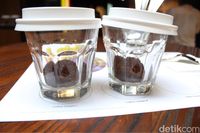Jakarta – Before it becomes a delicious cup of coffee. Coffee has gone through a long process. After the roasting process, the coffee must first be tested by a cupping process.
The cupping process can be said to be a stage for testing the taste of coffee, but many also say that this is the art of evaluating a cup of coffee. Usually cupping itself is carried out by professional coffee enthusiasts, such as baristas, roasters, and coffee exporters.
 Photo: detikFood Photo: detikFood |
Also Read: Continuing to Evolve, Coffee Becomes a Trend and Promising Business in Indonesia
But at this ‘Coffee and Cafe Workshop’ event, all participants can learn and get to know each other cupping process directly. Here, participants are invited to test the taste of several types of coffee with different processing methods, one of which is semi-wash coffee and honey process coffee.
ADVERTISEMENT
SCROLL TO CONTINUE WITH CONTENT
“You could say that cupping is a way of evaluating coffee objectively without filters, which is done all over the world. No one uses machines. So we really rely on our senses,” said Aris Kadarisman, always giving a lecture from the Indonesia Coffee Academy, on the sidelines of the event. This Coffee and Cafe Workshop (20/10).
 Photo: detikFood Photo: detikFood |
Also read: These are the stages of ‘Coffee Cupping’ to determine the quality of the taste and aroma of coffee
Aris further said that the coffee bean processing process consists of 4 types. There are natural, full wash, semi wash, and honey process. Among these 4 methods, semi wash and honey process are currently trending in the Indonesian coffee market.
“Semi wash is usually the method applied to coffee beans from Sumatra, through two drying processes but the process is faster than full wash. This honey process is currently in demand, because the taste is more fruity, because the coffee beans are dried in the sun until dry. Usually this is the honey process “It is widely applied in hot countries such as Brazil or Africa,” continued Aris.
Not only providing material, Aris also invited workshop participants to learn directly cupping together. In this workshop, Aris deliberately used semi-washed coffee powder and honey process. He asked the participants to rate these two coffees, there were 11 indications of value but the most emphasized were the value of taste, acidity level, aroma, and after taste.
 Photo: detikFood Photo: detikFood |
“Indeed, everyone has their own taste in coffee. It’s a little difficult to distinguish between types of coffee when cupping, but through this process we know which coffee is quality and which is just ordinary coffee,” continued Aris.
Even though it sounds complicated, the cupping process is quite easy. First, coffee beans that have been ground into powder are brewed with hot water at 200 degrees Celsius. Leave it for 4 minutes, using an agitation technique without tools to maintain the taste and aroma of the coffee when cupping.
The method of stirring and sipping coffee during the cupping process is not arbitrary. First, the spoon is dipped into the surface of the coffee. Then push it towards the edge of the cup before we smell the aroma for a few seconds. After that, rotate the spoon around the coffee cup, then push the spoon back to the edge, before smelling the coffee once again to confirm the aroma and become a benchmark for comparison with other coffee aromas.
After filling in all the cupping values, Aris then gave a conclusion. That semi wash coffee or wet coffee, tends to have a more vegetal or vegetable taste, and earthy or peanut flavor, with sweetness, and a slight trace of caramel.
Meanwhile, for honey process coffee, the flavors presented are more diverse. This type of coffee tends to have a fresher, fruity taste, with traces of berry, chocolate and sour flavors similar to honey.
Watch video: Wow! The trend of coffee lovers in Indonesia continues to increase
[Gambas:Video 20detik]
For overall value, Aris decided that coffee beans using the honey process method had a better aroma and aftertaste, because more flavors are present in one type of coffee, which is a sign of quality coffee.
“It’s been proven, isn’t it, that through the cupping process we will know better which coffee is better quality, and understand its taste and aroma,” concluded Aris.
Also Read: Want to Open Your Own Coffee Shop? Pay Attention to These 7 Important Things First
(dvs/odi)






